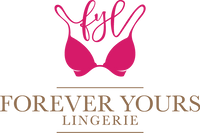Pink October - Breast Self-Exam
October is Breast Cancer Awareness Month and here at Forever Yours Lingerie, we love everything to do with boobs - especially their health!

Breast Cancer Awareness Month (Pink October) was created in 1985 to raise awareness and funding into screening and prevention of this disease.
While there has been significant research put into cancer and treatments since then, it is still prevalent. The Canadian Cancer Society reports that 1 in every 8 women in Canada will be diagnosed with breast cancer in their lifetime. This is an average of 78 Canadian women being diagnosed with breast cancer every single day.
These statistics are why regular self-checks are extremely important as it can help you familiarize yourself with your breast tissue and notice any abnormalities in their early stages.
So, let’s get to it and dive into a step-by-step breast self-assessment:
Step 1 - Overall Visual Appearance Exam
First things first, get your boobs out and stand in front of a mirror that gives you a complete view of your chest. Next, put your hands on your hips with confidence and take in all the beauty. Take a good look at what you’ve got and get familiar with their appearance!
What’s extremely important in this step is noticing the shape, contour and size of your breasts. Changes in texture and colour of the skin on your breast, nipples and areolas should be noted during a self-assessment.
Step 2 - Angles
It’s recommended to add a few viewpoints into your self-assessment. Try leaning forward with your hands on your hips, breathing in to assess your chest, and raising your arms above your head to see if your breasts move to the same degree. You’ll need to take note of your breasts drape, shape and symmetry to note any changes.
Changes that you should definitely keep an eye out for:
- Reddish spots or rashes
- Itchiness or pain
- Dimpling, discoloration or swelling
- Asymmetry in breast size is common but any sudden changes in breast size should be noted
- Noticeable and visible lumps
- Unusual or multiple pronounced veins in any of the breasts
Step 3 - Lymph Nodes
Make sure to look at your lower armpit area to see if you have any suspicious lumps, knots or swelling in your lymph nodes.
Step 4 - Nipple Inspection
Your nipples can say a lot about your breast health; therefore, you have to ensure that you give them a little extra TLC during this process.
While facing the mirror, place your arms by your side and observe your nipples. Look for any bumps, puckering and dimples.
You can also pinch the nipple and stretch it out and let go to see if your nipple snaps back into place or if it sinks in (repeat with the other nipple).
Step 5 - Physical Assessment
This is where things get a little hands on - so don’t be shy.
There’s a few recommendations here so choose whatever makes you feel comfortable:
Laying Down: On a sofa or bed, lay down with one elbow raised above your head. Laying down helps spread the breast tissue out which will make it easier to feel around. Use the pad of your three middle fingers to press down on your breast. Start by pressing lightly then gradually adding pressure as you move around your breast tissue and underarm. After you assess your breast, alternate to the next and repeat the process.
Ps. Don’t forget to slightly pinch your nipples. This will help you identify any unusual leaking fluids. Blood or clear discharge should be taken note of, especially if the discharge is only coming from one breast!
Standing Up: Using the same process as above, you can do this standing up in the shower. There are some recommendations to do so after body wash or soap has been applied to help reduce friction on your skin and get a better feel of things!
We do have some additional information we’d like to share:
Found Something Suspicious?
Keep in mind that if you do find an unusual lump, most lumps and bumps are benign and could be the result of hormone changes, an injury or benign breast conditions. However, stay calm and don't hesitate to contact a doctor to assess further if it is something bothersome and/ or a change in your breast health.
Don’t Forget Your Mammograms!
Self-assessments shouldn’t replace your regular mammograms if you are in the age or risk group for breast cancer screening.
Mark it on Your Calendar!
Make a breast self-assessment a regular self-care routine ritual. If you are still menstruating, make sure it’s a week or so after your monthly period ends. This can help reduce discomfort during a breast examination.
One More Thing!
Ask a medical professional to demonstrate or give you guidance for self-assessment breast checks if you are not confident about your own self-assessment.
If you’d like to learn more about Breast Cancer Awareness Month and where you can help out or donate to the cause, please check out the Canadian Cancer Society.
- - -
And remember,
Make Yourself a Priority
- Sophia
Resources:
Breast Self-Exam (breastcancer.org)
https://www.hcgoncology.com/blog/your-guide-to-breast-self-examination/
https://www.nationalbreastcancer.org/breast-self-exam
https://www.mayoclinic.org/tests-procedures/breast-exam/about/pac-20393237


